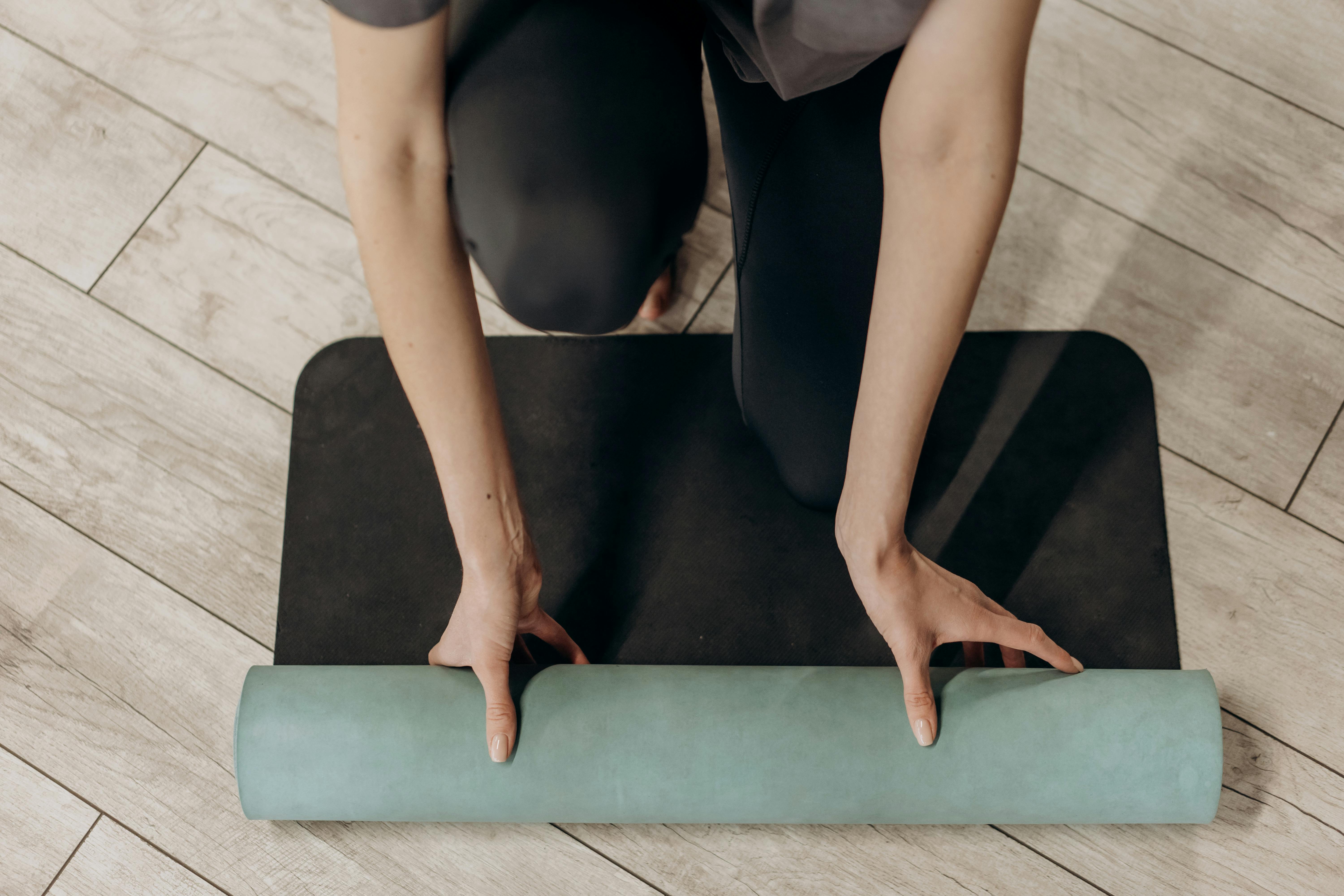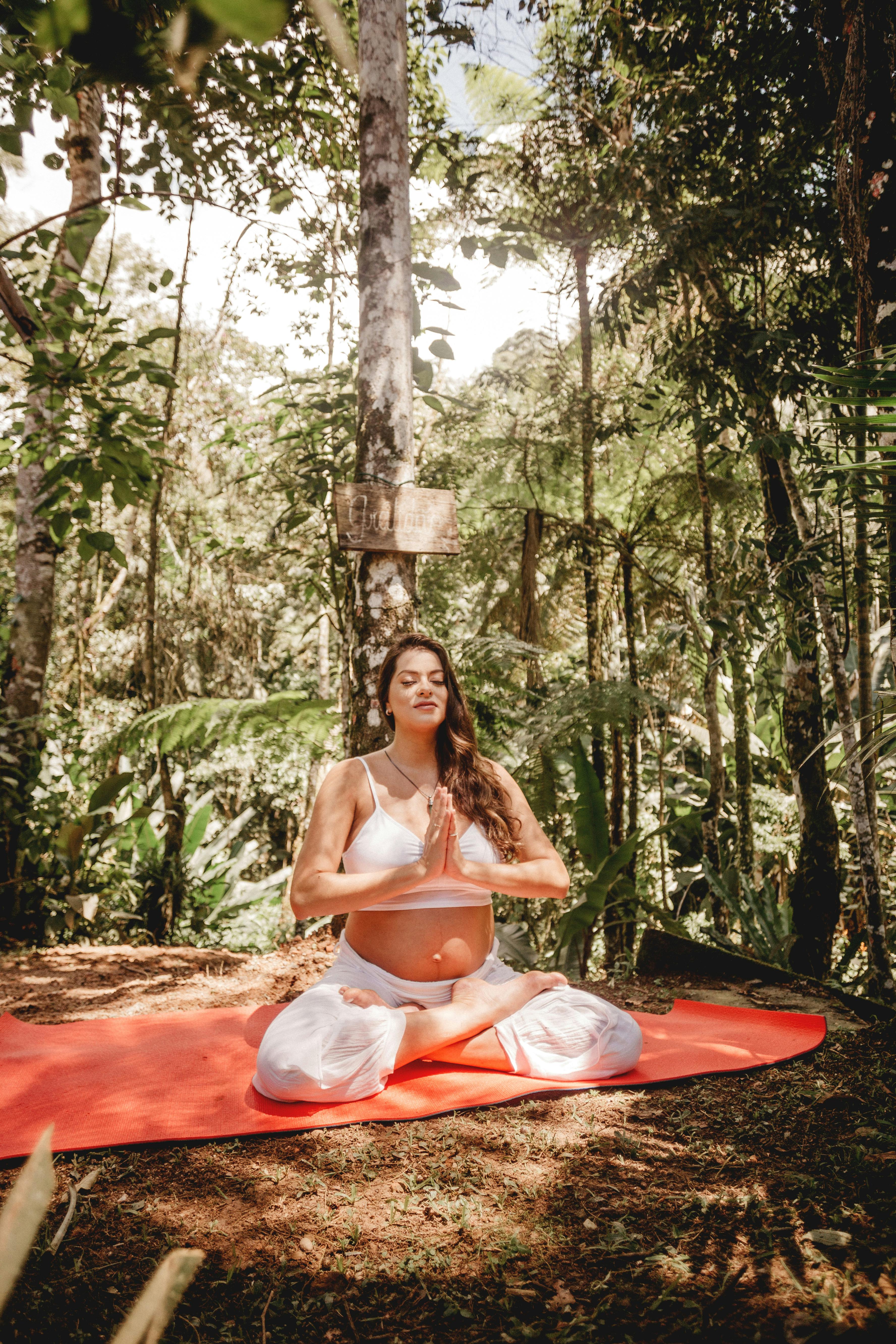Yoga isn’t all about the accessories. You can practice yoga anywhere, even in bed. However, a few things can make your asana practice easier, more comfortable, and more effective. At the top of that list is a yoga mat.
For starters, yoga mats provide traction. Not slipping will help you maintain postures and transition in and out of them safely.
Having really good grip will also help activate your muscles for the best effects, such as when you’re rooting through the hands and feet.
Yoga mats also provide padding, making them more comfortable than wood or tiles. Your knees will thank you.
For these reasons, a yoga mat can certainly elevate your practice.
Owning a mat that’s ideal for you can help you build up a regular practice. When it’s time to get your own mat, consider:
- Material – for durability, support, cleanability, and respect for the planet
- Thickness – for stability and comfort
- Texture – for grip
- Price – for still being able to buy yourself a coffee or green tea
Your choice of material is the most important of these, because it will impact the texture and price, as well as because you can align your yogic principles with your purchase, help protect the planet, and integrate an important principle of yoga—care for nature.
The Importance of Eco-Friendly Materials
In addition, environmentally-friendly materials aid the durability of the planet and our existence on it.
As yogic principles teach us to live in harmony with nature, being mindful about the clothes we wear and the equipment we use during yoga, is yoga.
The first of the eight limbs of yoga is ahimsa, which can be translated as “non-harming.” By educating ourselves and making informed decisions about our kit, we can minimize harm to the environment and inspire others to do the same.
Businesses have responded to the popularity of yoga by providing many products to help yogis practice. Unfortunately, many of those products have a significant, negative impact on the planet, through how they are made, packaged, or disposed of when their time comes.
However, there are also manufacturers that either care about the planet or care about the demand for eco-friendly materials. This means you can certainly find many great mats with a low carbon footprint! By buying natural materials from ecologically responsible businesses, we can help protect our beloved planet and encourage other manufacturers to make decisions that correspond with our philosophy.
Harmful Yoga Mat Materials to Avoid

Most yoga mats on the market are made from synthetic materials. About half of these, around 17 million mats per year, are made from polyvinyl chloride (PVC).
Synthetic materials damage the environment during at least one stage of their lifecycle:
- sourcing the materials
- manufacturing the product
- packaging the mat
- using the product
- disposing of it
For example, while PVC is inexpensive, depending on the quality, durable, and easy to clean, manufacturing PVC is energy-intensive and produces harmful byproducts. Additionally, disposing of a PVC yoga mat is bad for the planet.
You can get eco-polyurethane. These mats can be used safely. They are considered better for the environment than plastics, but this material also doesn’t biodegrade well.
EVA foam is often used because it’s lightweight. However, it isn’t biodegradable.
Plastics like these are also bad for us. While they are currently ubiquitous, the evidence suggests that it’s wise to limit our exposure to them. Microplastics can enter our system via our skin, ingestion, and inhalation. But what’s the big deal? The toxic chemical additives and pollutants in these plastics have been found to alter hormone activity (endocrine disruption), which can impair growth, cognition, and reproduction. Researchers are urgently investigating the potential links between using plastics and incidents of serious diseases, like cancer.
It’s worth taking a serious stance on the health impact of using plastic, as well as sparing a thought for vulnerable workers, including children, who are routinely exposed to contaminants and pollution during the plastic creation process and informal waste collection.
Even if you find a mat that seems all good on the eco front, it’s a good idea to check out the manufacturer to ensure their practices, processes, and materials are indeed as they seem.
Natural Material Choices

Material and quality determine how long your mat will last. Think about how often you will use it, how you will transport it, where you will use it, and how you’ll be storing it to consider your durability needs.
Mats made from natural materials can perform just as well as or even better than those manufactured from synthetic materials.
Good quality eco mats are:
- Durable
- Grippy
- Low-impact on the planet during production
- Generally odor-free
- Biodegradable
- Ridiculously good-looking
And, despite concerns, you can easily find an eco-friendly yoga mat that’s both durable and affordable.
While eco yoga mats combine natural materials, or natural and synthetic materials, you may also wish to consider how your mat will be packaged—will it come in recyclable cardboard or single-use plastic?
Voting with your money can influence how big companies do business. Let the following details—and your conscience—be your guide.
Natural Rubber
Natural rubber has excellent grip and these mats are biodegradable. High-quality rubber mats are also incredibly durable. It’s great for any type of yoga—slow and gentle like yin yoga, or high-energy and intensive like ashtanga or power yoga. However, check where the rubber came from to assess the extent to which it may have contributed to a loss of biodiversity, pollution, and deforestation.
Cork
Cork is naturally antimicrobial and odorless. Soft and yet firm, it might feel a bit slippery at first. Once you get the hang of it, it provides excellent grip, which can come in handy during sweaty power yoga sequences as the grip gets better with a little moisture. Similarly to natural rubber, cork is great for transitioning between positions..
Cotton
Similarly to cork, the grip can feel a bit slippery at first. Getting a bit sweaty makes the grip better. And don’t worry, cotton mats are easily machine-washable.
The grip of cotton may also encourage you to use your muscles a little differently due to shifts in the fabric as you move. However, cotton yoga mats aren’t as good for vigorous practices as our two previous materials. If you usually focus on gentle stretches, however, it may be the perfect choice.
Check that the cotton is certified 100% organic! Pourquoi? Because making non-organic cotton is extremely pesticide-heavy. According to some estimates, cotton production uses almost a quarter of the world’s insecticides and about a tenth of global pesticides.
This toxic spray gets into workers, soil, and water systems in a variety of ways. Ultimately, these toxic materials get into us, so authentic organic growing practices are far safer for all of us and our environment.
Wool
A wool mat will provide superior cushioning and warmth, making it a great choice for your winter yoga practice. Thick, soft, and super-comfortable, they are ideal for meditation and gentle or slower kinds of yoga, such as yin yoga, yoga nidra, or restorative yoga.
Other Factors to Consider to Choose Your Yoga Mat
Consider Thickness for Support and Portability
Mat thickness impacts stability and your contact with the floor.
A thick mat might be around a quarter of an inch thick and weigh up to around 7 lbs. This type of mat provides ample cushioning, so it’s ideal for bigger bodies, restorative yoga sessions, or practices involving holding fewer poses longer.

Mat thickness comes to the fore during poses where you’re resting on your forearms or kneeling. If you have aching joints, a thicker mat might suit you.
You might also like a thick mat if you regularly do yoga (or plan to do yoga) on a very hard surface, such as a hardwood floor or in a yoga studio, or if you’d like an extra balance challenge as a thicker mat will generally make you feel a little less stable.
While super-thin mats might lack padding for your knees or larger bodies, they are awesome for traveling because they are lightweight and easy to roll up and pack. They are also good for more active sessions and those focused on balance.
If this sounds like a mat for you, note that thin mats can still have textured surfaces, which can maximize grip. A thin mat might weigh around 2 lbs.
Center in on Size—So Your Hands and Feet Don’t Stick Out
The standard size of a yoga mat is about 68 inches long by 24 inches wide. That’s about 173cm (5’7’’) by 61cm. To get the most comfortable mat for you, think about the size of your body and how much mat you’ll need to avoid being on the hard floor.
I heard about people being annoyed by “oversized mats” in a yoga studio. Have you come across this?
People don’t like you to be comfortable? Stick with the mat, change your yoga studio!
Or do your yoga online. Put your safety and comfort first.
Bonus Tip 1: Wear Yoga Socks
If the mat you’re eyeing doesn’t quite meet your needs for grip, you can wear yoga socks with grips to improve your traction on any mat.
Bonus Tip 2: Use a Yoga Towel
If you’re concerned about getting your mat too sweaty (which could lead to slipping on some materials while making others grippier), you can keep it clean and dry with a yoga towel. This can make your mat last longer and may improve grip, too.
Bonus Tip 3: Use Props When Appropriate
Did you choose a thin, grippy, easy-to-transport mat? Awesome! But you’re now worried that your knees will feel it in table top pose. The solution? Roll up a blanket or towel and place it under your knees—or whatever body part—to feel more comfortable.
Unification of Mind, Body, Spirit … and Mat
Like Suli connecting with his dragon in Avatar or Harry connecting with his wand, there is a mat out there for you. The right mat will enhance your practice, help you look forward to your sessions, and be helpful but unobtrusive so you can focus on your asanas.
This guide should help you cut through the noise so that you can choose the best and most eco-friendly mat to get the most from your practice.
Now that you know what’s important to you about your future mat, check out David’s laser-focused review of the 14 best eco yoga mats of 2024.












